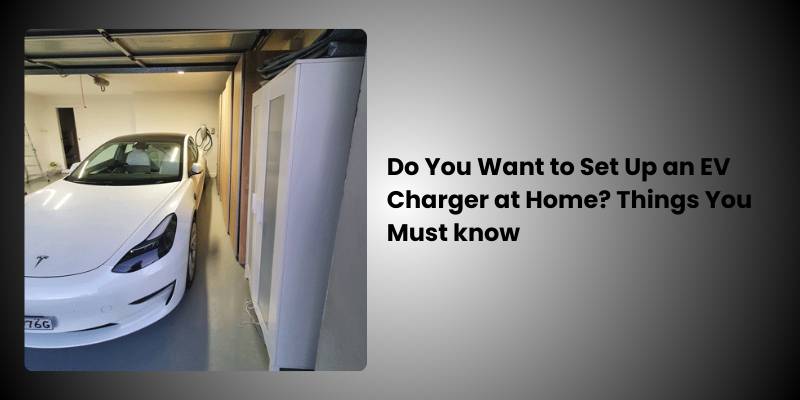It can be frustrating if you must go to an external charging station to charge your electric vehicle. And spending extended hours waiting for a full charge adds to the challenge. What if a solution brought the charging convenience to your doorstep? It is possible – you need to set up an EV charger at your home. This is a respite to electric vehicle owners and those thinking of buying an electric vehicle in the future. However, you must know certain things before setting up an electric vehicle charger at your home, explained here under:
Choose the Power Source for the Charger
The charger requires a power source to recharge your vehicle, and you have two primary options for home charging:
- Solar Power:Opt for solar energy if you are environmentally conscious or seeking energy savings. You must connect a solar panel to the charger, which will let you harness sunlight during the day. And if solar panels are already installed at your home, they can also power the charger.
- Electrical Power:Alternatively, you can directly draw power from the grid. While this method may be costlier and contribute to carbon emissions, it offers the flexibility to charge your vehicle day and night.
Verify the Power Phase
Determine whether your home is connected to the grid via a single-phase or three-phase power system. The power phase can impact EV charging in the following ways:
- Single-phase: Australian homes using a single-phase connection operate at a lower voltage of 230V. With a functional single-phase, charging your vehicle may take more time, and there’s a risk of overloading the system.
- Three-phase:Larger houses might have a three-phase connection, providing more power for faster charging. Three-phase connections boast higher capacity, allowing additional connections without overloading the system.
Aim for a three-phase connection if you’re seeking a new connection and plan to install an EV charger. However, the power phase has minimal impact if you intend to recharge the vehicle overnight.
Evaluate the Electrical Load
An EV charger, like other electrical appliances, has the potential to draw considerable power from the grid, increasing the overall load on your system. Calculating the load of existing appliances in your home is crucial to determine if adding a charger will overload the system.
A single-phase connection, with its lower capacity, is particularly susceptible to quick overloads. Therefore, careful consideration is necessary if you have a single-phase connection. Hiring a licensed electrician is advisable to accurately calculate the load and assess the suitability of adding a new EV charger.
Assess Space in the Electrical Panel
For connecting the new EV charger to the electrical system, available space in the electrical panel is essential. If your panel is an older model or already complete, consider replacing it with a new board that can accommodate additional installations.
Seek the expertise of a professional electrician to determine whether the current switchboard is suitable for integrating the new EV charger.
Determine the Charger Placement
While you can install the charger anywhere, the most suitable and cost-effective location requires careful consideration.
If you’re utilising a dedicated solar panel to supply power, ensure the charger is installed in an area with direct sunlight exposure.
In the case of drawing power directly from the grid, proximity to the nearest power outlet is crucial. A considerable gap between the charger and the grid-connected power outlet may necessitate additional expenses on wiring.
Select the Charger Type and Familiarise Yourself with Charging Levels
Before deciding on a charger type and charging level, one must understand a key detail: electric vehicles use Direct Current (DC), while power from the grid is Alternating Current (AC). To address the issue, a converter is built inside the car to change AC into DC, which reduces the charging speed.
Charger Types: Physical Plug Connectors
The EV market worldwide features various chargers tailored to specific vehicles, but Australia has standardised plugs for EVs. The most common plug types in Australia include:
- Type 2 (Mennekes) for AC charging, and
- Both CCS and CHAdeMo are used for DC charging.
Charging Levels: Power Bands
In Australia, there are three primary charging levels, with two commonly found in homes:
- Level 1:Utilising an existing power slot (10-15 Amp single phase), this level has a lower power range, adding an average of 10 to 20 km per hour plugged in.
- Level 2:Employing a dedicated AC charger at up to 22 kW (32 Amp three-phase), this level adds an average of 40 to 100 km per hour plugged in.
Choose the optimal combination of charger type and charging level based on the available power phase and the time you can allocate for charging your vehicle.
Select a Reputable Brand
When investing, ensuring its value is crucial. Opt for a well-known brand when choosing an EV infrastructure provider. Renowned brands uphold quality standards, offer warranties, and provide after-sales services. Explore recommendations from reliable sources to identify top-notch companies in the field.
Engage an Experienced Electrician
Avoid attempting a DIY installation for your EV. According to Australian law, licensed electricians must handle all permanently wired electrical installations. Therefore, enlist the services of a licensed level 2 electrician with extensive industry experience. A seasoned electrical service provider alleviates most of the hassle and provides valuable advice and practical solutions.





